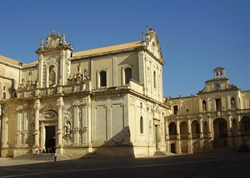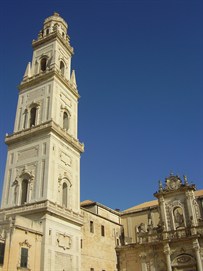The Cathedral and Pappacoda’s desired urban transformation
 Faithful to the dictates of the Council of Trent, Pappacoda devoted great attention to the control of cultural and intellectual production in Lecce. He strove therefore for the implementation of the Index of Forbidden Books so that the system of ecclesiastical censorship be more effective than the secular. This policy is clearly expressed in the synodal edict De non legendis, nec retinendis libris prohibitis promulgated by Pappacoda in 1663, which had the negative effect of stifling cultural and literary life in Lecce, which was quite lively until the arrival of the powerful bishop. Writers and poets were called upon to adhere to the guidelines of the bishop, and to celebrate the success of his political and pastoral policies. One example is the Accademia dei Trasformati (Academy of the Transformed), founded by Scipione AmmiratoScipione Ammirato (1531-1601) was an historian and writer. A prominent exponent of the tacitismo (whom he celebrated in his Discorsi sopra Cornelio Tacito), he was among the authors who most questioned the reason of state, which he defined in an anti-Machiavellian way. Having embarked on an ecclesiastical career, he founded the Accademia dei Trasformati (Academy of the Transformed) in his hometown of Lecce. He lived from 1569 until his death in Florence. A canon of the cathedral, he wrote the Istorie fiorentine on behalf of Cosimo I de ‘Medici. between 1558 and 1560, which became extinct at the beginning of Pappacoda’s episcopate and was then reconstituted by Giovanni Camillo Palma in 1651 as an effective instrument of consensus and celebration for the bishop.
Faithful to the dictates of the Council of Trent, Pappacoda devoted great attention to the control of cultural and intellectual production in Lecce. He strove therefore for the implementation of the Index of Forbidden Books so that the system of ecclesiastical censorship be more effective than the secular. This policy is clearly expressed in the synodal edict De non legendis, nec retinendis libris prohibitis promulgated by Pappacoda in 1663, which had the negative effect of stifling cultural and literary life in Lecce, which was quite lively until the arrival of the powerful bishop. Writers and poets were called upon to adhere to the guidelines of the bishop, and to celebrate the success of his political and pastoral policies. One example is the Accademia dei Trasformati (Academy of the Transformed), founded by Scipione AmmiratoScipione Ammirato (1531-1601) was an historian and writer. A prominent exponent of the tacitismo (whom he celebrated in his Discorsi sopra Cornelio Tacito), he was among the authors who most questioned the reason of state, which he defined in an anti-Machiavellian way. Having embarked on an ecclesiastical career, he founded the Accademia dei Trasformati (Academy of the Transformed) in his hometown of Lecce. He lived from 1569 until his death in Florence. A canon of the cathedral, he wrote the Istorie fiorentine on behalf of Cosimo I de ‘Medici. between 1558 and 1560, which became extinct at the beginning of Pappacoda’s episcopate and was then reconstituted by Giovanni Camillo Palma in 1651 as an effective instrument of consensus and celebration for the bishop.
 The isolation of Lecce from the general culture of the period, but also with respect to the capital, Naples, had therefore deletrious effects on the development of literary, philosophical, scientific and intellectual debate within the city. At the same time, Pappacoda’s desire to celebrate his achievements and to give substance to the bishopric which had regained prominence led him to finance a spectacular program of urban renewal over the years, thanks to which Lecce can claim itself today to be an authentic jewel of the Italian Baroque. Pappacoda entrusted the reconstruction of the Cathedral (photo 1), built in 1144, to Giuseppe Zimbalo, his favourite artist. Work began in 1655 and lasted until 1670, while the bell tower (photo 2), designed and planned by Zimbalo, was completed only in 1682, after his death. About 70 metres high, it consists of five tapered floors with an image of Saint Orontius on top of an iron weathervane, the patron who Pappacoda so desired for his city.
The isolation of Lecce from the general culture of the period, but also with respect to the capital, Naples, had therefore deletrious effects on the development of literary, philosophical, scientific and intellectual debate within the city. At the same time, Pappacoda’s desire to celebrate his achievements and to give substance to the bishopric which had regained prominence led him to finance a spectacular program of urban renewal over the years, thanks to which Lecce can claim itself today to be an authentic jewel of the Italian Baroque. Pappacoda entrusted the reconstruction of the Cathedral (photo 1), built in 1144, to Giuseppe Zimbalo, his favourite artist. Work began in 1655 and lasted until 1670, while the bell tower (photo 2), designed and planned by Zimbalo, was completed only in 1682, after his death. About 70 metres high, it consists of five tapered floors with an image of Saint Orontius on top of an iron weathervane, the patron who Pappacoda so desired for his city.
